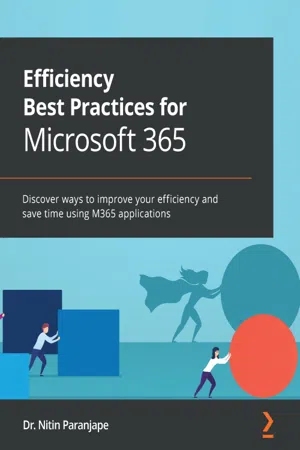
- 350 pages
- English
- ePUB (mobile friendly)
- Available on iOS & Android
Efficiency Best Practices for Microsoft 365
About This Book
A practical guide to working with Microsoft 365 apps such as Office, Teams, Excel, and Power BI for automating tasks and managing projects effectivelyKey Features• Learn how to save time while using M365 apps from Microsoft productivity expert Dr. Nitin Paranjape• Discover smarter ways to work with over 20 M365 apps to enhance your efficiency• Use Microsoft 365 tools to automate repetitive tasks without codingBook DescriptionEfficiency Best Practices for Microsoft 365 covers the entire range of over 25 desktop and mobile applications on the Microsoft 365 platform. This book will provide simple, immediately usable, and authoritative guidance to help you save at least 20 minutes every day, advance in your career, and achieve business growth.You'll start by covering components and tasks such as creating and storing files and then move on to data management and data analysis. As you progress through the chapters, you'll learn how to manage, monitor, and execute your tasks efficiently, focusing on creating a master task list, linking notes to meetings, and more. The book also guides you through handling projects involving many people and external contractors/agencies; you'll explore effective email communication, meeting management, and open collaboration across the organization. You'll also learn how to automate different repetitive tasks quickly and easily, even if you're not a programmer, transforming the way you import, clean, and analyze data.By the end of this Microsoft 365 book, you'll have gained the skills you need to improve efficiency with the help of expert tips and techniques for using M365 apps.What you will learn• Understand how different MS 365 tools, such as Office desktop, Teams, Power BI, Lists, and OneDrive, can increase work efficiency• Identify time-consuming processes and understand how to work through them more efficiently• Create professional documents quickly with minimal effort• Work across multiple teams, meetings, and projects without email overload• Automate mundane, repetitive, and time-consuming manual work• Manage work, delegation, execution, and project managementWho this book is forIf you use Microsoft 365, including MS Office 365, on a regular basis and want to learn about the features that can help improve your efficiency, this book is for you. You do not require any specialized knowledge to get started.
Frequently asked questions
Information
Section 1: Efficient Content Creation
- Chapter 1, Fortunately, You're Inefficient!
- Chapter 2, Components of Work
- Chapter 3, Creating Content for Effective Communication
- Chapter 4, Intelligent Data Analysis
- Chapter 5, Managing Files Efficiently
Chapter 1: Fortunately, You're Inefficient!
- What's in it for you?
- Evaluating your inefficiency
- Inefficiency audit – how to find your own inefficiency
- Why are there so many features?
- Discovering your needs behind features
- Moving from a vicious cycle to a virtuous cycle
- Frequent questions answered
Technical requirements
What will you gain by reading this book?
- Detect inefficiency.
- Learn how to find a more efficient method.
Evaluating your efficiency
Fitting a table in a Word doc

Table of contents
- Efficiency Best Practices for Microsoft 365
- Contributors
- Preface
- Section 1: Efficient Content Creation
- Chapter 1: Fortunately, You're Inefficient!
- Chapter 2: Components of Work
- Chapter 3: Creating Content for Effective Communication
- Chapter 4: Intelligent Data Analysis
- Chapter 5: Managing Files Efficiently
- Section 2: Efficient Collaboration
- Chapter 6: Time and Task Management
- Chapter 7: Efficient Teamwork and Meetings
- Section 3: Integration
- Chapter 8: Automating Work without Programming
- Chapter 9: Putting It All Together
- Chapter 10: Maximizing Efficiency across the Organization
- Other Books You May Enjoy